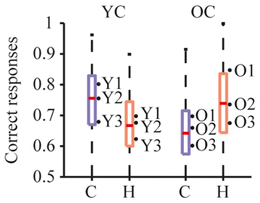Research Abstract
顔知覚の発達過程
Developmental processes in face perception
2013年1月9日 Scientific Reports 3 : 1044 doi: 10.1038/srep01044

顔知覚がどのように発達するのかを解明するために、これまで多くの研究がさまざまな方法を用いて行われてきた。しかし、知覚的狭小化のような経験予期型の機構(初期経験成分)と、その後の一生にわたる経験(後期経験成分)が、顔情報の処理にどう寄与しているかは、まだはっきりとわかっていなかった。我々は今回、集団飼育下の異なる年齢のチンパンジーを調べることで、顔認知の発達におけるそれぞれの経験成分の効果を分離することに成功した。これらのチンパンジーは、異種の顔に対して特異的な経験を一生を通じて持つという、貴重な例である。顔弁別実験の結果、若齢のチンパンジーでは、ヒトの顔の弁別よりも同種であるチンパンジーの顔の弁別のほうが成績がよかった。これは、主に初期経験成分の寄与によって、顔の知覚系が同種の形態の認知へと調節されていることを示している。また、高齢のチンパンジーでは、チンパンジーの顔の弁別よりもヒトの顔の弁別のほうが成績がよく、これは、主に後期経験成分が、高い接触量を持つ種の顔において重要な特徴を処理するように知覚系を調節することを反映している。我々は、これらの結果をもとに、コンピュテーショナルモデリングを用いることで、初期と後期の経験成分の寄与をシミュレートし、そこに潜在する関数を数理的に記述した。
Christoph D. Dahl1, Malte J. Rasch2, 友永 雅己1 & 足立 幾磨1
- 京都大学 霊長類研究所 思考言語分野
- 北京師範大学 認知神経科学・学習研究所(中国)
Understanding the developmental origins of face recognition has been the goal of many studies of various approaches. Contributions of experience-expectant mechanisms (early component), like perceptual narrowing, and lifetime experience (late component) to face processing remain elusive. By investigating captive chimpanzees of varying age, a rare case of a species with lifelong exposure to non-conspecific faces at distinctive levels of experience, we can disentangle developmental components in face recognition. We found an advantage in discriminating chimpanzee above human faces in young chimpanzees, reflecting a predominant contribution of an early component that drives the perceptual system towards the conspecific morphology, and an advantage for human above chimpanzee faces in old chimpanzees, reflecting a predominant late component that shapes the perceptual system along the critical dimensions of the face exposed to. We simulate the contribution of early and late components using computational modeling and mathematically describe the underlying functions.

